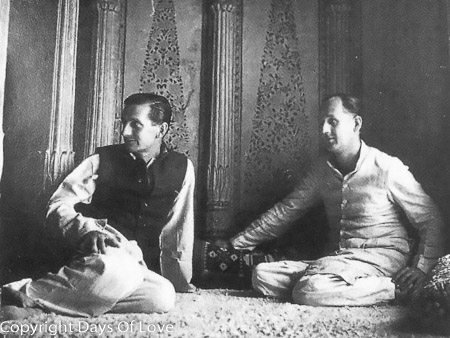 Alain
Daniélou (4 October 1907 – 27 January 1994) was a French historian,
intellectual, musicologist, Indologist, and a noted Western convert to and
expert on Shaivite Hinduism.
Alain
Daniélou (4 October 1907 – 27 January 1994) was a French historian,
intellectual, musicologist, Indologist, and a noted Western convert to and
expert on Shaivite Hinduism. Partner Raymond Burnier
Queer Places:
Colle Labirinto, Via Colle Labirinto, 24, 00039 Zagarolo RM, Italia
 Alain
Daniélou (4 October 1907 – 27 January 1994) was a French historian,
intellectual, musicologist, Indologist, and a noted Western convert to and
expert on Shaivite Hinduism.
Alain
Daniélou (4 October 1907 – 27 January 1994) was a French historian,
intellectual, musicologist, Indologist, and a noted Western convert to and
expert on Shaivite Hinduism.
In 1991, he was awarded the Sangeet Natak Akademi Fellowship the highest honour conferred by Sangeet Natak Akademi, India's National Academy for Music, Dance and Drama.[1]
His mother, Madeleine Clamorgan, was from an old family of the Norman nobility; a fervent Catholic, she founded schools and a religious order, Order of Sainte-Marie, for women teachers in civilian costume under the patronage of St. François-Xavier. His father, Charles Daniélou, was an anticlerical Breton politician who held numerous national ministerial posts in the Third Republic. One of his brothers was Roman Catholic prelate and Académie française member, Jean Daniélou.[2]
He received his education at the Institution Notre-Dame de Sainte-Croix, Neuilly-sur-Seine, and at St. John's College, Annapolis.[2] The young Daniélou studied singing under the famous Charles Panzéra, as well as classical dancing with Nicholas Legat (teacher of Vaslav Nijinsky), and composition with Max d'Ollone. Subsequently, he performed professionally on stage with dancers like Floria Capsali and Marjorie Daw.[2] Growing up he rebelled against his mother's deep devotion to her faith, but his father remained a positive influence, which helped in developing his musical talent and in coping with his homosexuality.[3] He studied piano and singing, learning the songs of Duparc and Chausson and the Lieder of Schumann and Schubert. He started writing poems, as acquired proficiency in English and other European languages.[2]
He and his partner, Swiss photographer Raymond Burnier, first went to India as part of an adventure trip, and they were fascinated with the art and culture of the nation. Daniélou and Burnier were among the first Westerners to visit India's famed erotic temples in the village of Khajuraho and Burnier's stunning photographs of the ancient temple complex launched the site internationally. The photographs were featured in an exhibition at the New York's Metropolitan Museum.[4]
In 1932, during his first trip to India, he met one of the great influences poet Rabindranath Tagore.[2] His close association with Rabindranath Tagore lead to him being the director of Tagore's school of music at Shantiniketan (Visva-Bharati University).[5] Subsequently, in 1935, he joined the Banaras Hindu University, where he studied Hindu music, Sanskrit, Indian philosophy and Hindu religion for the next 15 years. In 1949, he was appointed as a research professor at the University, a post he held until 1953. he also remained the director of the College of Indian Music. In Banaras (now Varanasi), he lived a mansion on the banks of the Ganga, named Rewa Kothi. During these years, he studied Indian classical music in Varanasi with Shivendranath Basu and played the veena, which he started playing professionally. He also studied Hindi, Sanskrit languages as well as Indian philosophy. His interest in the symbolism of Hindu architecture and sculpture, lead to long trips with Burnier to Khajuraho, Bhubaneswar and Konarak, sites in central India and Rajasthan.[5][6] He also translated some works of Swami Karpatri by whom he was initiated into Shaivism under the name Shiva Sharan (Protected by Shiva).[2][7]
In 1953, he joined the Adyar Library and Research Centre at the Theosophical Society Adyar near Madras (now Chennai), where he was the director of a centre of research into Sanskrit literature until 1956. In 1959, he became a member of French Institute of Pondicherry, which works in the field of Indology.[2]
Upon his return to Europe in 1960, he was appointed an adviser to UNESCO's International Music Council, which led to a number of recordings of traditional music such as Unesco Collection: A Musical Anthology of the Orient, Musical Atlas, Musical Sources and Anthology of Indian Classical Music - A Tribute to Alain Daniélou. In 1966, he became the founder and director of the International Institute for Comparative Music Studies and Documentation in West Berlin, where he remained till 1977; he also remained the director of the Istituto Internazionale di Musica Comparata in Venice from 1969 to 82.[2]
He worked on classical Indian music. But his more important contribution to Indology is his writings on the ancient wisdom of the Veda, Hindu philosophy, and Shaivism.
He is the author of over thirty books on Indian music and culture. He received several awards for his work on music. He was also a photographer and artist.
He was an Officer of the Légion d'Honneur, an Officer of the Ordre National du Mérite, and Commander of Arts and Letters. He was the director of the UNESCO Collection series, a series of recordings of traditional world music. In 1981, he received the UNESCO/CIM prize for music, and, in 1987 the Kathmandu Medal from UNESCO.
In 2004, to mark his tenth death anniversary a photo exhibition, "India through the eyes of Alain Danielou (1935-1955)" was hosted at the Alliance Française, Hyderabad.[5]
My published books: